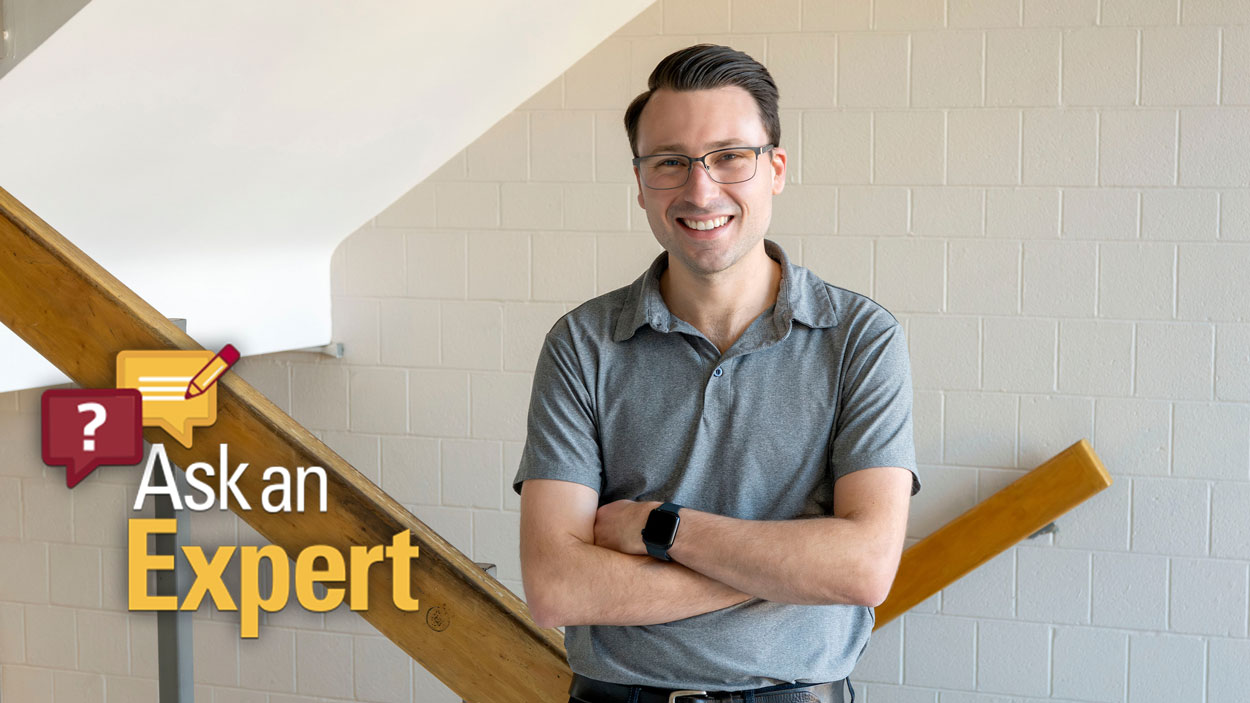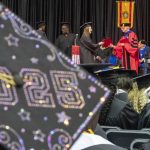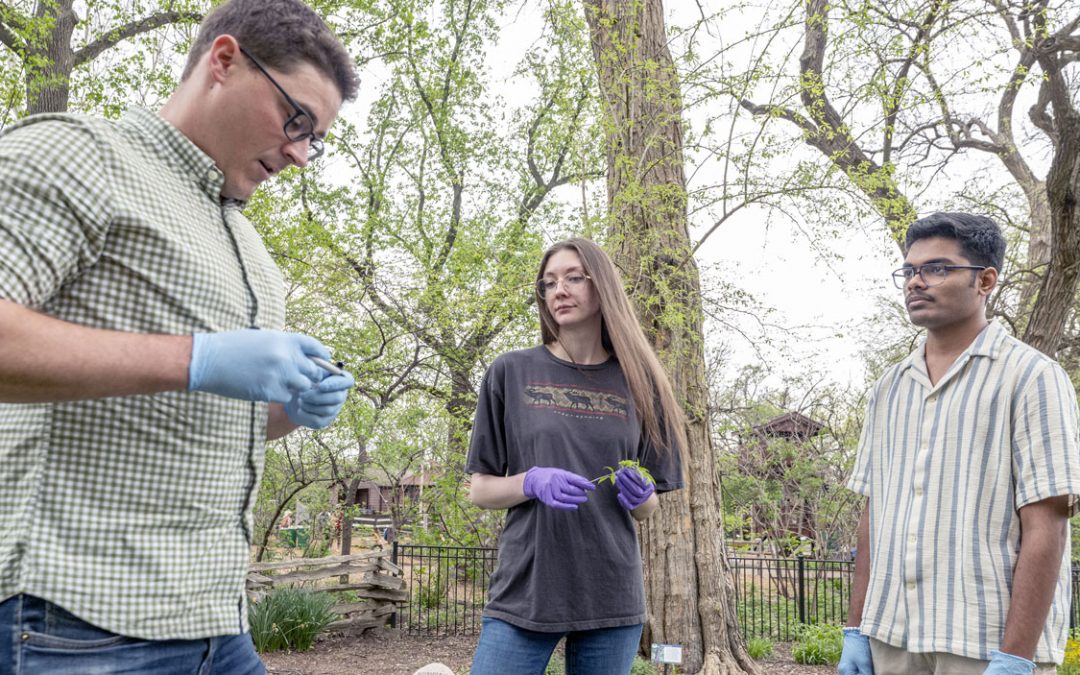
Brian Adler is an assistant teaching professor of sociology at the University of Missouri–St. Louis. His work focuses on the connections between housing, governance and society. He also teaches courses on sociology and urban communities. (Photo by Derik Holtmann)
Brian Adler grew up in Los Angeles, the second most populous city in the United States. Despite his upbringing, Adler didn’t really become interested in urbanism until he moved to St. Louis to pursue his bachelor’s degree.
“When I came to St. Louis, I began thinking and learning more about urbanism, because despite our problems, we have a better urban landscape than cities on the West Coast like Los Angeles,” he said. “In my college years, I got around pretty much exclusively by taking transit. Even though we don’t have a big transit system, I was still able to do things that I never imagined or even thought I could do in Los Angeles. I really enjoyed having those urban amenities. So, now I care, and I’m an evangelist about all of those amenities that we do have and that we should have more of.”
In addition to becoming an urban evangelist, Adler went on to earn an MPAA at the University of Missouri–St. Louis and is currently working toward a PhD in public and social policy. As an assistant teaching professor of sociology at UMSL, Adler’s work focuses on the connections between housing, governance and society. He also teaches courses on sociology and urban communities.
In our latest installment of the Ask an Expert series, UMSL Daily spoke with Adler about revitalizing Downtown St. Louis, downtown “doom loops” and more.
A Wall Street Journal article published last April declared that Downtown St. Louis is in a “doom loop.” For those unfamiliar, can you explain what that means?
Absolutely. A “doom loop,” as they have defined it in their other articles, has to do with the loss of some core industry, a reduction in tax revenues, worsening services, declining businesses, the number of businesses, more crime and disorder and residents leaving.
I agree with that general definition. But I don’t think Downtown St. Louis fits that criteria, and we have a number of metrics that are just starkly in opposition to what they define themselves as a doom loop. One, and I think this is the most important one, Downtown has been one of our most quickly growing neighborhoods, at least between 2010 and 2020. There is not population loss Downtown. Rather, this one neighborhood grew by 46.3% within those 10 years. That’s astonishing, because the entire city is in population decline. So, Downtown was so successful in terms of residential population that it was offsetting a lot of decline happening elsewhere in the city.
Beyond that, the Downtown CID, the community improvement district that is collecting a lot of tax revenues there, representing sales taxes, and the way folks spend their money Downtown, is showing higher revenues now in 2024 than it was showing in 2019 back when everyone agreed there was some momentum Downtown. We are actually seeing higher tax revenues, way more residents.
We have some metrics that are really a good cause for optimism and others that are a little bit concerning, but at least on a few different metrics here we do not match their own definition of a doom loop.
The article proposes a combination of reasons for the current state of Downtown – population loss, which you just pointed out isn’t quite true, competition from the suburbs and misguided urban planning. Does that sound accurate to you? Is one culprit bigger than the other, as far as where Downtown is right now?
Of course, we don’t have population loss. It’s actually incredible population growth. So not only is that not a culprit, but that’s something that we can leverage to advance Downtown. Remote work definitely seems as though it has hurt Downtown. This is not something unique to St. Louis, either – every single city has to deal with this problem. To some degree, we might be seeing that confronted with return-to-office mandates happening across the country, so that might help a little bit.
But what planners and academics are typically leaning on and learning now is that we don’t want to put all of our eggs in one basket. We want to have office workers, residents, people visiting for the great restaurants and sports venues and entertainment venues at night. The idea is to have more of an 18-to-20-hour city, rather than an eight-hour city, where people just commute in, commute out. But our downtown is still structured and built for being an eight-hour city. It is surrounded by highways. It has incredibly large roadways, tons and tons of surface parking lots. It’s not designed yet to be for the residents and people coming in for leisurely activities. It’s designed primarily for one use, and so those misguided efforts designing a city are still haunting us today.
Now, there are plans to change some of that, like with the Tucker Boulevard Cycle Track and road diet. That’s huge. But I will also say when I had to go to City Hall to get some document, I was trying to cross one street to get to City Hall, and there was no safe pedestrian crossing to do so right at the heart of our downtown. Those are the things that we need to confront, as well as things like suburban competition.
We need to compete on being the place where people like to spend their time, and if they want to work there too, great, but there’s plenty of other opportunity for people to go Downtown, whether it’s sports, leisure, restaurants or being just a great place to live.
You mentioned remote work. Empty office space is often at the forefront of discussions about downtown revitalization. In St. Louis, people often point to the AT&T Center. I’ve heard some suggest converting it to housing or a hotel, which could be expensive, while others think it should just be razed to the ground altogether and redeveloped. What do you think should or could be done with an asset like that?
These assets are mysteries, and I don’t think I or anyone else has the one answer, but I will say there’s perhaps some cause for optimism. Right now, there’s rumors coming out about a potential redevelopment plan from Denis Beganovic, a Downtown resident who tracks all Downtown development. He’s talking about rumors of a new mixed-use plan with 625 new apartments, 80,000 square feet of commercial retail and converting some of the building floors to parking, because the site lacks ample parking right now.
What we’re seeing is a recognition that downtowns are places for people to live and places for people to shop. I expect that no matter what, even if this plan doesn’t come to fruition, you’re going to see a mix of hotel, apartments and retail. Those are things that are successful in downtowns right now. Moreover, we are seeing pretty good absorption of residential units Downtown, typically for new conversions. We’ve had hundreds and hundreds of new apartment units come online, and that’s been an attractive thing for people to go and live there so far.
So, I think no matter what, you can’t put all your eggs to one particular use. You have to do multiple things at once to make sure you are spreading your risk across different types of investment assets. All of those things build off of one another. If you’re building retail, you want more residents. If you’re building residential units, they’re going to want retail. They will all work together in conjunction to create a more successful development.
With regard to razing the building, I think that would be a little bit silly. At this point, the City of St. Louis has passed a number of initiatives to make sure that ample incentives are going to be available for this property.
As you mentioned, business is not the only ingredient to creating a vibrant downtown district; it also requires residents and residential property. How can we keep attracting residents to Downtown and build on that momentum?
It’s essential building on that residential momentum, because that is going to then foster commercial momentum and maybe even office momentum. The major thing is making sure people want to live there, because it is going to then set forth some kind of domino effect where all other kinds of investment become easier and more successful, because they do build off one another.
Now, there’s a host of things that we can do. One is making sure we’re giving residents a good reason to live there, and so focusing on mixed-use developments makes it such that people are closer to the amenities that they desire. Making sure that people can access interesting stores, making sure they can access pharmacies so they can get their prescriptions, being able to walk to grocery stores, making sure there’s movie theaters and restaurants. If we build those things where the residents are and make it a not miserable experience to get those amenities, then you create a pretty unique type of landscape for St. Louis that would be matching some of the best practices around the country.
Right now, we’re doing some of this, but not a ton of this. We’re building a lot of new apartments Downtown. Most of them are coming through historic renovations and rehabilitations, and those are really important in terms of reactivating old buildings. Oftentimes they’re not necessarily adding in the mixed uses, because these are old industrial buildings where it’s hard to build a new storefront in.
We need to make sure we get new construction with dedicated retail base, such that you don’t need to go walk past a whole bunch of municipal court buildings and whatnot to go access those amenities. That’s one of the core issues with our downtown right now as I see it. You need to walk past so many unactivated institutional uses with nothing really in between you and your destination that is going to be that interesting, or even places for you to spend your dollars.
Can these investments potentially be spurred with economic development incentives and tools, such as a tax increment financing district, tax abatements or a community improvement district?
Sure, it is a frequent thing that is happening here in St. Louis. It’s rare to see a new development come online in St. Louis without some kind of incentive. There’s a lot of discourse surrounding this, but one of the key issues here is that development is exceedingly expensive. New construction – very, very pricey. We have a host of rules and regulations that make it even more difficult, both in time and cost, with spurious requirements. With regard to tax incentives, we’re seeing some shifting ground right now.
Tax increment financing districts are out of style. I don’t believe that we’ve approved a new TIF in two or three years in the city of St. Louis. Tax abatements and CIDs are probably going to be the two most frequent types of incentivized tools that we’re going to use. Tax abatements, for those who might be unaware, are when we’re essentially saying, “After you build this structure, we expect that it’s going to deliver some higher amount of property taxes based off the improvements, so you’ll pay a percentage of that for the next five, 10 or 15 years.” Oftentimes, this has been kind of excessive, where we’ll say, “Well, for the next 15 years, you’re only going to pay 5% of your assessed property taxes.” It depends on the development and also the benefit that it’s going to provide the city. Lawmakers in the region are constantly trying to determine what the right balance is, and there’s no one simple answer.
The other, more frequently used tool we’re seeing is CIDs, community improvement districts. These are a little bit wacky. You can have a community improvement district like The Grove, the entire corridor along Manchester between Vandeventer and Kingshighway. All of those businesses contribute some percentage of their sales tax revenue to a quasi-governmental structure that then spends some of that on infrastructure like lighting and sidewalks and other important amenities for businesses and residents in that area. Those are frequently used for corridors, but they’re also sometimes used for specific developments. You can essentially draw a district around one building, where some of those sales taxes are used to support the financing operations for that one development. We see that happen more and more, where a building might get a CID, a tax abatement, maybe something else, too, to make sure the financing works.
We have these tools, and then we also have the institutions in the region. How could a higher education institution like UMSL possibly help these efforts?
We have a fantastic Master of Public Policy Administration program. This program is helping train some very qualified practitioners to go work in local planning departments and with developers around the entire region. I say this in a very self-serving way, because I’m a grad of that program. I think it’s spectacular, and we have some amazing students and faculty. Beyond that, we have a fantastic certificate in planning and zoning that a lot of people around the region are coming to UMSL for to make sure that they are applying best practices when it comes to urban policy. We ideally could keep building on these programs to set forth a positive vision for the region.














